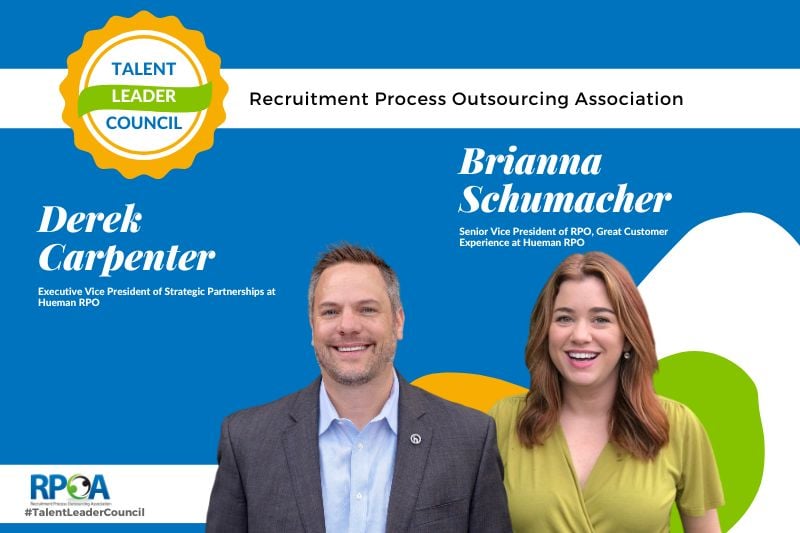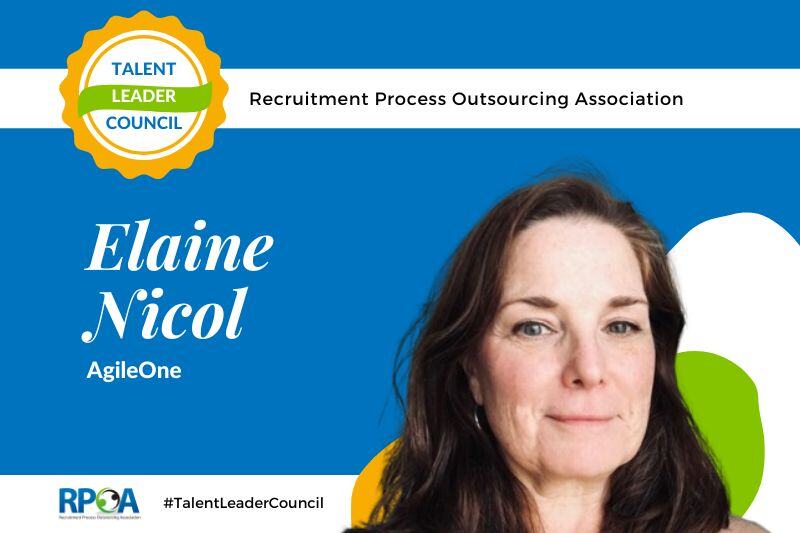
Successful recruitment process outsourcing (RPO) partnerships require collaboration, communication, and a commitment to continuous improvement. The fast pace of talent acquisition demands agility, which means RPO providers must adapt alongside their partners.
In this Talent Leader Council article, talent leadership from Hueman RPO shares valuable insights on using a holistic talent acquisition strategy to build and sustain highly effective RPO partnerships. Brie Schumacher, Senior Vice President of RPO Great Customer Experiences, and Derek Carpenter, Executive Vice President of Strategic Partnerships, share best practices for customized partnership management, measuring success, benchmarking performance, and ensuring alignment across organizations. Ultimately, the goal is to empower RPO providers and their client partners to drive their talent acquisition capabilities to new levels of excellence together.
Below is an AI-generated and human-edited version of their interview.
RPOA: How Does Hueman Align its RPO Solutions with Clients’ Talent Acquisition Requirements?
Carpenter: At Hueman, we apply a holistic strategy to talent acquisition that integrates people, process, technology, digital recruitment marketing, and data and reporting, encompassing many of the services outlined in the report. We aim to ensure that our partners operate in the top 10 percent across all areas of this strategy and become best-in-class talent acquisition organizations.
Accomplishing this goal starts with people. Hueman's dedicated recruiters eat and breathe our partners' requisitions. Our recruiters work under the brand and banner of our partners and act as salespeople promoting their organization's culture, mission, and values. Through professional management techniques, we ensure recruiters are held accountable, engaged in collaborative goal setting, and are a holistic part of the solution.
Regarding the process, we examine our partners' recruiting and sourcing functions, requisition generation, interview and screening processes, orientation, and onboarding to see where we can streamline inefficiencies. In today's fast-paced hiring environment, we aim to expeditiously move candidates through the process, all while keeping them engaged with our partner’s organization.
For technology, we ensure our partners have a best-in-class technology stack. To acquire this tech stack, our partners must have an optimized applicant tracking system (ATS) configured for optimal workflows. With an optimized ATS, Hueman can integrate appropriate additional platforms based on our partners' overall strategies and goals.
It's essential to have in place a robust digital recruitment marketing plan to proliferate jobs. We always ask ourselves, “Are we casting a big enough net to ensure we have more candidates at the top of the funnel?” To ensure we populate the top of the funnel with quality candidates, having a sound employer brand and having an employee value proposition (EVP) aligned with it is essential. The EVP is critical in selling what separates our partner’s company from its competitors and the promises of what life will look like for candidates who come to work for them versus someone else.
The digital footprint must also support the organization's goals, such as increasing the diversity of hires. Within the digital realm, it's important for the website to speak with a brand voice that supports this goal.
Finally, data and reporting validate strategies and progress through metrics rather than assumptions. Systems extract actionable reports showing customized strategies' effectiveness for data-driven decision-making.
For data and reporting, the ATS needs to output reports to validate our recruitment strategies. We want to make data-based decisions, so we may need to use Power BI or build another system to extract data.
At Hueman, we customize our talent acquisition strategies for each recruitment partnership because each partner has unique circumstances. For example, it's easier to recruit in Chicago, Illinois, than in Del Rio, Texas, because of the population. We engage deeply with market analytics to understand the population and supply-and-demand characteristics. Our team will use this data to adapt the overall strategy according to individual circumstances
Q: Does Hueman's Holistic Approach Work for One Type of Engagement and Not Others (ie, enterprise, selective, and project RPO)?
Carpenter: We apply the same holistic approach regardless of engagement type or size. Whether it's an enterprise partnership or a single recruiter seat, our focus remains on optimizing processes and providing best-in-class recruitment solutions.
Customization also depends on the partners' current capabilities and goals. Partners with a less sophisticated TA program receive help reaching the 90th percentile across all areas of People, Process, Technology, Recruitment Marketing, and Reporting. Partners with a more advanced TA program receive targeted expertise on specific initiatives. The overarching goal remains to elevate our partners to recruitment industry leaders through knowledge and consulting.
Schumacher: I agree with everything Derek said. But there's a tactical nuance with the project-based model. If it's a six-month, nine-month specific project, the focus is on specific deliverables, such as recruitment and marketing, rather than a comprehensive DEI or business alignment strategy. We offer project-based partners various options to choose from as they build their projects.
Q: What Are Some Best Practices to Ensure Successful RPO Partnerships?
Carpenter: We nurture a "can't fail" mentality where leadership views the partnership strategically rather than temporarily helping overcome challenges. Both parties must commit to solving issues together.
Alignment across the partner organization prevents internal resistance from threatening the relationship and, ultimately, results. Operational teams and leadership must embrace partnership goals.
Appointing a program champion drives internal change and transformation. This person advocates for initiatives and helps turn strategies into action.
Schumacher: Successful RPO partnerships require routine communication and feedback. It's essential to have regular bi-weekly or monthly check-ins and monitor progress against previously established objectives and goals. With changes in recruitment from day to day, it's vital to use metrics and feedback to help adapt and adjust to any sudden changes or challenges to established objectives and goals. As the RPOA report points out, the success of an RPO partnership hinges on aligning with business strategy and meeting quality measures, as well as KPIs. The ultimate goal is to ensure a positive experience for all stakeholders involved in the partnership, including hiring managers, candidates, and the organization.
Q: How Do You Measure Partnership Success?
Schumacher: Success relies on treating partnerships as true collaborations, not transactions. To assess the relationship's success, we use specific KPIs and goals set out in a contract for each partner. We take a composite score of different things such as tracking targets, regular communication, Net Promoter Scores (NPS), and internal evaluations to determine if we're meeting our partner’s goals and identifying areas for improvement.
Q: How Do You Manage Ongoing Partnerships?
Schumacher: Regular communication ensures objectives remain aligned as business needs evolve. It also allows flexibility in adapting to shifting market conditions outside the partners' control.
To that end, we provide our partners with dashboards for ad hoc and transparent real-time updates and communication with the recruitment team. They can communicate with us through this platform and have access to productivity metrics at their fingertips. We conduct weekly calls with them to ensure we align with their business needs and provide innovative solutions. In addition, we also have monthly and quarterly strategic communication to avoid getting lost in tactical details.
During the quarterly business review, we compare their performance against industry benchmarks and other partner accounts. This review helps us identify any broken processes or inefficiencies and enables us to make recommendations for improvement. We have access to data for 50 partnerships and can compare each partner's performance against them, picking and choosing which partnerships to compare against. These comparisons are essential to our process and help us build case studies to showcase our production output.
In Conclusion
Successful RPO partnerships require collaboration, communication, and a commitment to continuous improvement. Hueman RPO's holistic talent acquisition strategy, which includes people, process, technology, digital recruitment marketing, and data and reporting, is tailored to meet each partner's unique needs. By optimizing processes and providing best-in-class recruitment solutions, Hueman RPO aims to empower its partners to drive their talent acquisition capabilities to new levels of excellence.
Read more interviews from the Talent Leader Council blog series.






-min.jpg)







